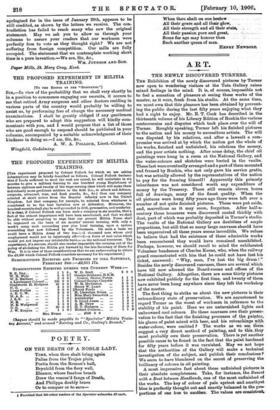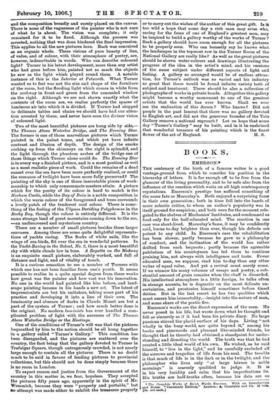ART.
THE NEWLY DISCOVERED 1.0 ANERS.
THE Exhibition of the newly discovered pictures by Turner now open to wondering visitors at the Tate Gallery raises
mixed feelings in the mind. It is, of course, impossible not to feel a sensation of pleasure at seeing these works of the master, as it were, fresh from his studio. At the same time, we must own that this pleasure has been obtained by prevent- ing the public during the last fifty years enjoying what they had a right to enjoy. Mr. E. T. Cook has described in the thirteenth volume of his Library Edition of Ruskin the various controversies and disputes which took place over the will of Turner. Roughly speaking, Turner left his finished pictures to the nation and his money to necessitous artists. The will was disputed by his relations, and after a lawsuit a com- promise was arrived at by which the nation got the whole of his works, finished and unfinished, his relations the money, and the poor artists nothing. After some delay, the chief oil paintings were hung in a room at the National Gallery, and the water-colours and sketches were buried in the vaults. These last were eventually arranged and a part of them mounted and framed by Ruskin, who not only gave his service gratis, but was actually allowed by the representatives of the nation to pay for the framing himself ! Apparently this princely inheritance was not considered worth any expenditure of money by the Treasury. There still remain eleven boxes full of drawings, many of the finest quality. When the oil pictures were hung fifty years ago there were left over a number of not quite finished pictures. These were put aside, and, marvellous as it may seem, forgotten. After half-a- century these treasures were discovered coated thickly with dust, part of which was probably deposited in Turner's studio. The vaults of the National Gallery are doubtless of ample proportions, but still that so many large canvases should have been unperceived all these years seems incredible. We refuse to believe that had the existence of these admirable works been remembered they would have remained unexhibited. Perhaps, however, we should recall to mind the exhilarated Volunteer bandsman of Charles Keene, who, when the railway guard remonstrated with him that he could not have lost his ticket, answered : " Why, man, I've lost the big drum ! " Besides the newly discovered canvases, there are several which have till now adorned the Board-rooms and offices of the National Gallery. Altogether, there are some thirty pictures now exhibited publicly for the first time, and twenty of them have never been hung anywhere since they left the workshop of the master.
The first thing to strike us about the new pictures is their extraordinary state of preservation. We are accustomed to regard Turner as the worst of workmen in reference to the stability of his paint. Here we see untarnished lights and unbrowned cool colours. Do these canvases owe their preser- vation to the fact that the finishing processes of the painter, his glazes of paint mixed with beer, and his retouchings with water-colour, were omitted ? The works as we see them suggest a very direct method of painting, and to titin, they most probably owe their preservation. There is yet another possible cause to be found in the fact that the paint hardened for fifty years before it was varnished. May we not hope that the authorities of the Gallery will make a technical investigation of the subject, and publish their conclusions P We seem to have blundered on the secret of preserving the brilliancy of colours in oil painting.
A most impressive fact about these unfinished pictures is their absolute completeness. Take, for instance, the Sunset with a Boat between Headlands, one of the most unfinished of the works. The key of colour of pale apricot and amethyst blue is perfectly thought out and exactly balanced in the pro. portions of one hue to another. The values are consistent,
and the composition broadly and surely placed on the canvas. There is none of the vagueness of the painter who is nob sure of what he is about. The vision was complete; it only remained for it to be fixed. Although the process was arrested, nothing that was done hindered the final impression. This applies to all the new pictures here. Each was conceived as an organic whole. These visions of pure beauty of line, of value, and of colour, with their atmosphere of poetry, are, however, indescribable in words. Who can describe coloured light P Turner in his latest development, more than any artist who had gone before him, painted not so much the objects he saw as the light which played round them. A notable instance of this is the Interior at Petworth. What Turner wanted us to feel was not the size and shape of the furniture of the room, but the flooding light which comes in white from the archway in front and green from the concealed window on the right. Although we are not shown exactly what the contents of the room are, we realise perfectly the spaces of luminous air into which it is divided. If Turner had stopped to delineate tables and chairs we should have had our atten- tion arrested by these, and never have seen the diviner vision of coloured light.
Two of the most beautiful pictures are hung side by side,— The Thames Above Waterloo Bridge, and The Evening Star. The former is one of those marvellous pictures which Turner painted in the palest tones, and which yet have infinite contrast and illusion of depth. The design of the smoke rushing up from the chimneys on the right is splendid, and the light through the phantom arches of the bridge one of those things which Turner alone could do. The Evening Star is in every way a finished picture, and is a most poetical as well as a most realistic piece of work. Could the remains of a dead sunset over the sea have been more perfectly realised, or could the romance of twilight have been more fully preserved P The painting of the sky is one of those inscrutable pieces of work- manship to which only consummate masters attain. A picture which for the purity of its colour is hard to match is the Norham Castle, while the Bay of Beim is a noble composition in which the warm colour of the foreground and trees surrounds a lovely patch of the tenderest cool colour. There is some- thing of the feeling of the Ulysses Deriding Polyphemus in the Rocky Bay, though the colour is entirely different. It is the same strange land of great mountains coming down to the sea, —an undiscovered and mysterious country.
There are a number of small pictures besides these larger canvases. Among these are some quite delightful representa- tions of yachts racing. The flocks of white sails, like the wings of sea-birds, flit over the sea in wonderfal patterns. In the Yacht-Racing in the Solent, No. 2, there is a most beautiful sky with white clouds low in tone. A Regatta on the Medway is an exquisite small picture, elaborately worked, and full of distance and light, and of vitality of touch.
It is a curious sensation to see a number of Turners with which one has not been familiar from one's youth. It seems possible to realise in a quite .special degree from these works how great was the painter and how vast was his innovation. No one in the world had painted like him before, and land- scape painting became in his hands a new art. The latest of impressionists are but his imitators, taking some part of his practice and developing it into a line of their own. The luminosity and absence of darks in Claude Monet are but a part of the system of Turner ; and how much better done is the original. No modern luministe has ever handled a com- plicated problem of light with the sureness of The Thames Above Waterloo Bridge or the Hastings.
One of the conditions of Turner's will was that the pictures bequeathed by him to the nation should be all hung together in a gallery called " Turner's Gallery." This condition has been disregarded, and the pictures are scattered over the country, the fact being that the gallery devoted to Turner in Trafalgar Square, though outrageously crowded, is not nearly large enough to contain all the pictures. There is no doubt much to be said in favour of lending pictures to provincial collections, but this should not be done simply because there is no room in London.
To expect reason and justice from the Government of the country in this matter is, we fear, hopeless. They accepted the pictures fifty years ago, apparently in the spirit of Mr Wemmick, because they were "property and portable," but 310 attempt was made either to exhibit the treasures properly or to carry out the wishes of the author of this great gift. Is it too wild a hope that some day a rich man may arise who, caring for the fame of one of England's greatest men, may be inspired to build a gallery worthy of the works of Turner P Such a gallery should have room enough for all the pictures to be properly seen. Who can honestly say he knows what the landscapes in the topmost row in the Turner Room of the National Gallery are really like P As well as the great pictures should be shown water-colours and drawings illustrating the progress of the idea in the artist's mind, and his versions of the same subject under different aspects of light and feeling. A gallery so arranged would be of endless attrac- tion, for Turner's outlook was so varied and his industry so great that there would be found infinite variety both of subject and treatment. There should be also a collection of photographs of works in private hands. Altogether this gallery might become a worthy monument to one of the greatest artists that the world has ever known. Shall we ever see the realisation of this dream P Who knows P Did not people in the past lament that there was no gallery devoted to English art, and did not the generous founder of the Tate Gallery remove a national reproach P Let us hope that some day "Turner's Gallery" may be built, and in it be enshrined that wonderful treasure of his painting which is the finest.











































 Previous page
Previous page